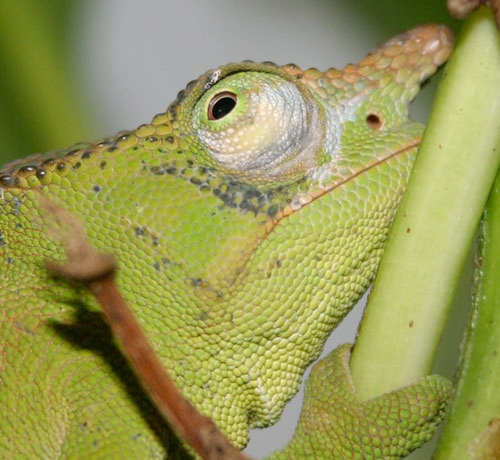



Questions and Answers
By Jason Descamps
Citation:
Descamps, J. (2006). Questions and Answers. Chameleons! Online E-Zine, September 2006. (http://www.chameleonnews.com/06SepDescampsQA.html)
Q. Hi Sir, have a question that need your help. Can I use 75watt-150watt metal halides with 6500k for my veiled chameleon? Pls help me.
A. You could use those lights for chameleons without issue if certain precautions are met. Metal halides are very intense bulbs that produce a lot of light and a lot of heat. These types of lights would only be appropriate for very large cages. Even though the wattage on your particular bulb is relatively low you would still be forcing a very large amount of light into a cage and a typically sized chameleon cage would be too small for this much light, UV and heat. I recommend that under normal circumstances UV be provided through the use of fluorescent bulbs designed specifically for reptiles. The ZooMed Reptisun 5.0 bulbs have been used for many years with a great success rate.
Q. Hi I'm no stranger to reptiles. Have bred water dragons, bearded dragons, mexican milk snakes, and basilisks, I also have skinks and a tegu, but I have to say this veiled cham is the most time consuming, he is 4-5 years old and now I’m treating him for gout by increasing H2O intake also pedialyte, his eyes are not sunken in and he still drinks from his fountain, but from what I have read about gout in chams is that it is increased protein break down and this will increase the uricd acid which will collect in the joints. His right wrist is swollen but is still functioning we caught it early. My question to you is what do you gut load your feeders I know how important the protein is but for adult cham I have read they don’t need as much and this is why adult chams tend to get the gout. my cham is by far my most interesting herp and I do not want to lose him. WHAT DO YOU GUT LOAD YOUR FEEDERS FOR YOUR ADULT CHAMS?
A. I'm sorry to hear about your chameleons troubles. In most cases gout is a result of suboptimal hydration and not increased protein breakdown. Diets that are excessively high in protein can lead to a greater occurrence of gout in captive chameleons but this is also usually related to suboptimal hydration. Chameleon kidneys lack the loop of henle and as such cannot concentrate and pass urine when water intake is low. This can lead to many health issues including gout. My first suggestion is to increase the animals water intake and exposure through prolonged, heavy mistings and showers. Fountains and water dishes do little to provide the necessary amounts of drinking water for a chameleon and have little effect on the relative humidity of the cage. These items can also quickly become bacteria broths and lead to other health issues. I would personally get rid of the fountain if it were me. The pedialite can be continued for a short time but your ultimate goal would be to eliminate this as a maintenance item. More information on water intake and it's role in gout can be seen in the November 2002 issue, ( nutrition - water )
In addition to these suggestions I would recommend a trip to a qualified reptile vet. A vet could give you a much better idea of the status of your chameleons health than anyone else could.
Regarding the gutload, there are many different gutloads available today and many different opinions on what constitutes a gutload. Some information that might help you make your decision can be found in the June 2005 issue, ( Gutloading Basics )
Q. I found you email browsing online trying to find out more information on signs of chameleon dehydration. I have a 6-7 month old Veiled male and I've never had any problems with him eating or drinking. However, I went out of town and my friend sitted "Louie" for me and when I got him back I noticed that his eyes were very dark. She used to be a vet tech and she said he ate great (7 crickets and 3-4 butterworms). I didn't think anything of it because he good and drank when I misted him that night. When I went to water mist him yesterday and I noticed his left eye blew up like a balloon and was very, very dark. That night I watched him sleeping and his right eye was nice and green and the left was very dark. He did the same thing today as well. I haven't noticed any yellow with his fecal matter and he's still eating, but he's not as active as he used to be. I've got him in a 165 gal. mesh reptarium with a hibiscus tree, UVA/UVB basking heat lamps and a long UVA/UVB light. I mist him religiously 3-4 times a day for at least 4-5 minutes. He usually enjoys the misting but today went and hid in the corner. Any input would be greatly appreciated. I love my Louie and would hate to know that I've done something wrong for him.
A. Without seeing your chameleon I'll just be making a guess here but my first inclination is that you are seeing a combination of a few things.
The eye bulging out when being misted is a very common occurrence in chameleons. Most chameleons utilize prolonged misting sessions to clean debris from their eyes. When doing this they will often "bilge" and roll their eyes in an effort to move water within the eyelid. Completely normal behavior.
The dark eyes could be any number of things. My first guess would be something in the eye that is causing irritation, which could also explain the eye bulging referenced above. It is also possible that there was some kind of trauma to the eye. Could be an insect bite, a fall, etc. Difficult to say for sure. If the skin remains dark for more than a few days it would certainly not be a bad idea to see a qualified reptile vet.
The issue of him retreating when sprayed is most likely a stress response. Chams are lovers of the routine. They like things to be the same everyday. Same people, same schedule, etc. Your cham could just be reacting to all the changes starting from the pet sitter and continuing with the eye dropper and the extra attention.
Regardless of the possibilities a vet visit would not hurt and would probably be beneficial to both you and your chameleon.
As a side note: The poster and I continued to correspond in regards to Louie’s eye issues. As of our last email he was under a vet’s care and was being treated with antibiotics. His condition was improving and he was beginning to return to normal. The posters quick reaction with veterinary care is the number one reason for Louie’s improvement.
Q. Let me first start by saying that I love reading Chameleons!. I am sorry to bother you, but I have a question that I hope you can answer. I was wondering if tomato worms (hornworms) are toxic to chameleons. I have a pair of Jackson's. I have been trying to research this and can not find a definitive answer. The chameleon forum that I am on was not very helpful on this matter. I received one reply that they were a great treat, and another reply that the wild caught worms are toxic due to the tomato leaves that they eat. I would appreciate any light that you can shed on this dilemma.
A. It's no bother at all, that is what we are here for.
Tomato hornworms can be a great addition to a chameleons diet. To answer your question wild hornworms do feed on plants in the Solanaceae family, which include tomato, peppers, eggplants, etc. The leaves and stems of these plants are toxic to most animals. So, as such, wild caught hornworms should not be fed to your chameleons. The good news is that many sources of captive cultured hornworms are now available and can be easily utilized as feeders for your chameleon. You can read more about hornworms and their use as a feeder in the December 2005 issue of the Chameleons! Online E-Zine, ( Hornworms )
Q. I keep seeing ads for a new morph of veiled chameleons. They are clear and look very cool. Can you tell me more about this cool new morph?
A. The “translucent” veileds (Ch. calyptratus) have recently become available in the US. While not much is known about the animals themselves this is indeed a genetic mutation. There have been many of us interested to see how these animals react with prolonged exposure to UV and if the trait is indeed recessive, as we believe it is. With any new “morph” I would suggest proceeding with caution you have no way of knowing for sure how these animals will be affected by this mutation. Do your homework and don’t fall for the uneducated individuals making broad, definite statements about these animals in an attempt to make a sale.

Female Bradypodion fischeri fischeri exhibiting a similar phenotype to the "translucent" veileds. Photo courtesy of Chris Anderson

Jason Descamps

Jason Descamps has been keeping and breeding reptiles and amphibians for over 12 years. To date he has worked with over 135 species of reptiles including breeding 18 species of chameleons. His current focus is creating a stable captive chameleon gene pool through the CCBTD and working with rarely bred chameleon species such as C. (Tr.) weidersheimi, C. (Tr.) werneri, and C. (Tr.) fuelleborni. Jason served as an assistant editor for the Chameleons! Online E-Zine from December 2005 through February 2008.









Join Our Facebook Page for Updates on New Issues:
© 2002-2014 Chameleonnews.com All rights reserved.
Reproduction in whole or part expressly forbidden without permission from the publisher. For permission, please contact the editor at editor@chameleonnews.com
